Crown Institute BSBFIM601 Finance Assignment Solution
VerifiedAdded on 2022/11/11
|17
|2603
|365
Homework Assignment
AI Summary
This document presents a comprehensive solution to a finance assignment, addressing key concepts in financial management. The assignment covers topics such as conservatism in accounting, relevant accounting standards (AASB 15, AASB 101), and the components of a complete set of financial statements. It explores features of off-the-shelf accounting software, provides calculations of revenue, gross profit, and net profit margins, and explains the formula for contribution margin. The solution also includes answers on budgeting, including incremental versus zero-based budgeting, and the importance of cash flow budgets. Further, it covers due diligence, aged payables management, and the significance of internal financial controls. Finally, it addresses the relationship between Australian Accounting Standards and accounting principles, the definition of financial probity, break-even analysis, and fringe benefit tax, along with ratio analysis. The solution also touches on organizational planning, business software, and audit trails, providing a detailed overview of financial management principles.
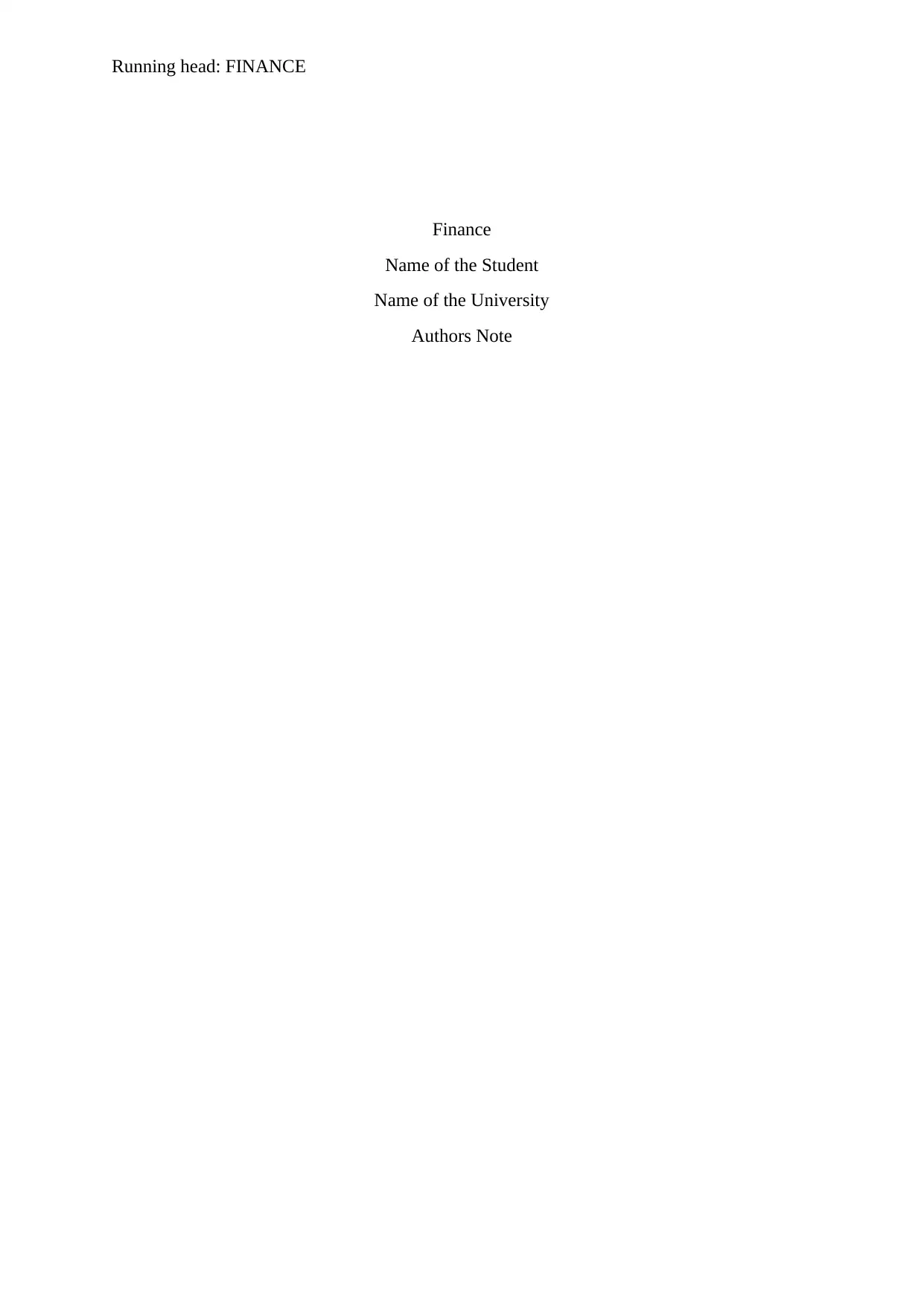
Running head: FINANCE
Finance
Name of the Student
Name of the University
Authors Note
Finance
Name of the Student
Name of the University
Authors Note
Paraphrase This Document
Need a fresh take? Get an instant paraphrase of this document with our AI Paraphraser
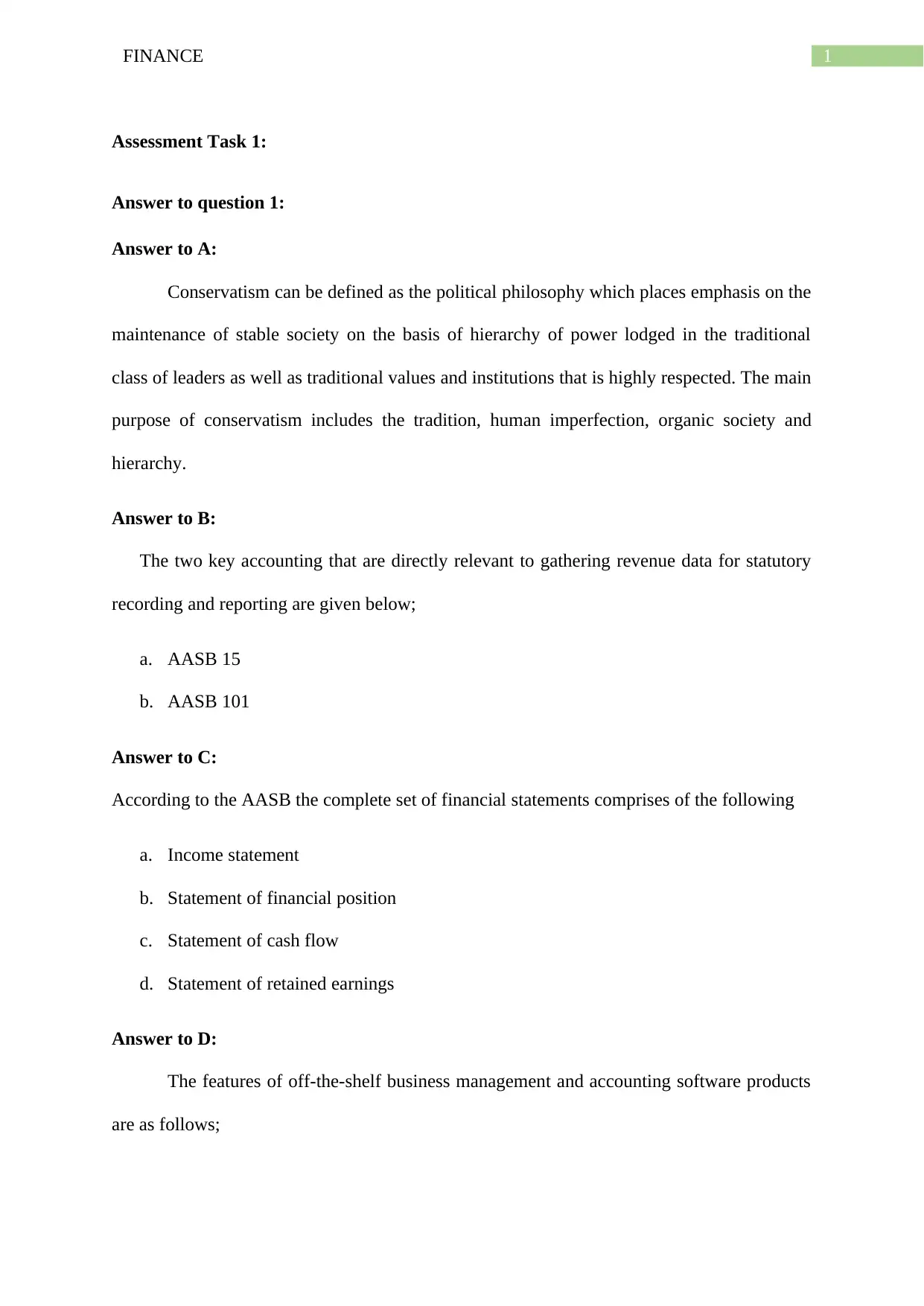
1FINANCE
Assessment Task 1:
Answer to question 1:
Answer to A:
Conservatism can be defined as the political philosophy which places emphasis on the
maintenance of stable society on the basis of hierarchy of power lodged in the traditional
class of leaders as well as traditional values and institutions that is highly respected. The main
purpose of conservatism includes the tradition, human imperfection, organic society and
hierarchy.
Answer to B:
The two key accounting that are directly relevant to gathering revenue data for statutory
recording and reporting are given below;
a. AASB 15
b. AASB 101
Answer to C:
According to the AASB the complete set of financial statements comprises of the following
a. Income statement
b. Statement of financial position
c. Statement of cash flow
d. Statement of retained earnings
Answer to D:
The features of off-the-shelf business management and accounting software products
are as follows;
Assessment Task 1:
Answer to question 1:
Answer to A:
Conservatism can be defined as the political philosophy which places emphasis on the
maintenance of stable society on the basis of hierarchy of power lodged in the traditional
class of leaders as well as traditional values and institutions that is highly respected. The main
purpose of conservatism includes the tradition, human imperfection, organic society and
hierarchy.
Answer to B:
The two key accounting that are directly relevant to gathering revenue data for statutory
recording and reporting are given below;
a. AASB 15
b. AASB 101
Answer to C:
According to the AASB the complete set of financial statements comprises of the following
a. Income statement
b. Statement of financial position
c. Statement of cash flow
d. Statement of retained earnings
Answer to D:
The features of off-the-shelf business management and accounting software products
are as follows;
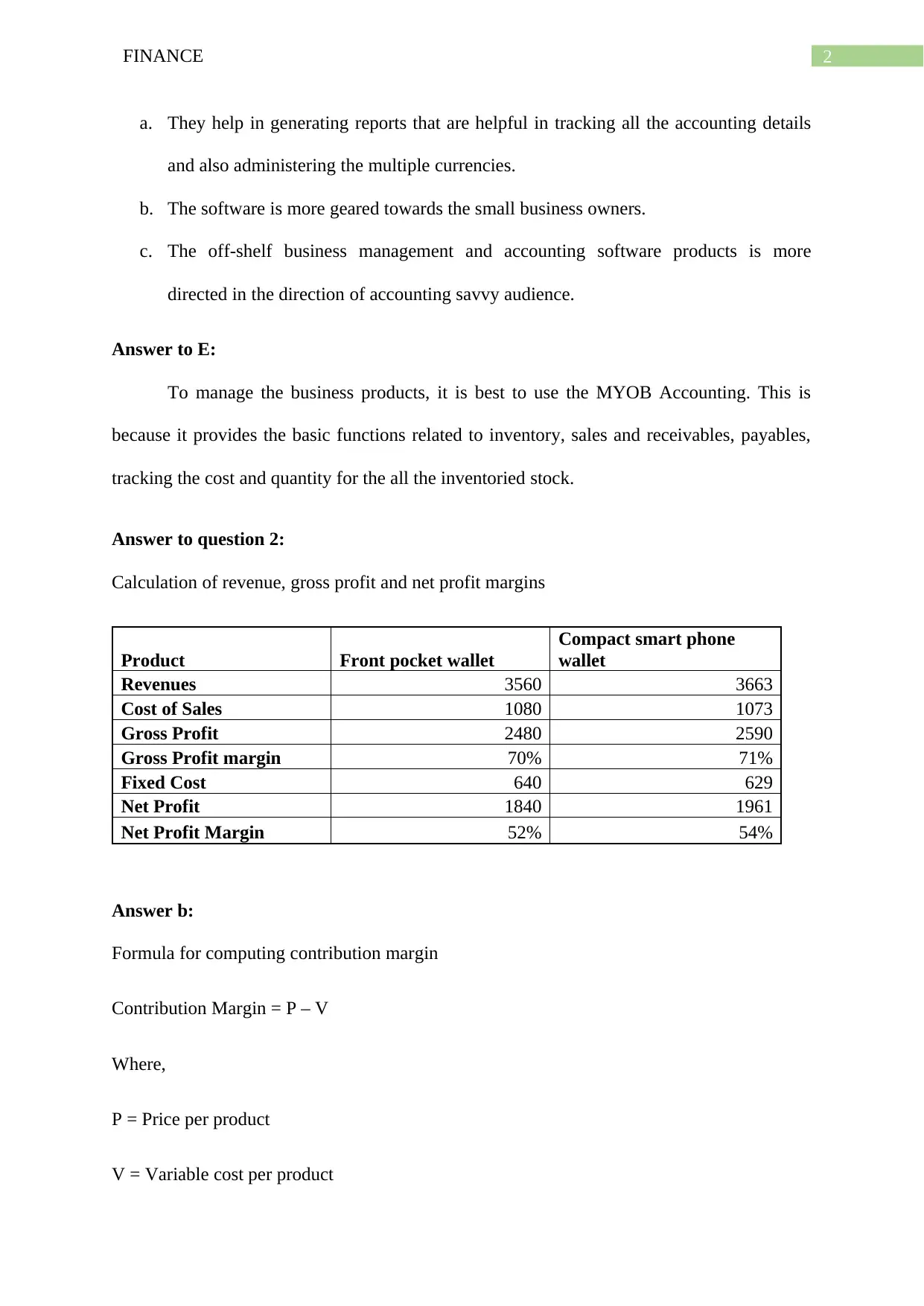
2FINANCE
a. They help in generating reports that are helpful in tracking all the accounting details
and also administering the multiple currencies.
b. The software is more geared towards the small business owners.
c. The off-shelf business management and accounting software products is more
directed in the direction of accounting savvy audience.
Answer to E:
To manage the business products, it is best to use the MYOB Accounting. This is
because it provides the basic functions related to inventory, sales and receivables, payables,
tracking the cost and quantity for the all the inventoried stock.
Answer to question 2:
Calculation of revenue, gross profit and net profit margins
Product Front pocket wallet
Compact smart phone
wallet
Revenues 3560 3663
Cost of Sales 1080 1073
Gross Profit 2480 2590
Gross Profit margin 70% 71%
Fixed Cost 640 629
Net Profit 1840 1961
Net Profit Margin 52% 54%
Answer b:
Formula for computing contribution margin
Contribution Margin = P – V
Where,
P = Price per product
V = Variable cost per product
a. They help in generating reports that are helpful in tracking all the accounting details
and also administering the multiple currencies.
b. The software is more geared towards the small business owners.
c. The off-shelf business management and accounting software products is more
directed in the direction of accounting savvy audience.
Answer to E:
To manage the business products, it is best to use the MYOB Accounting. This is
because it provides the basic functions related to inventory, sales and receivables, payables,
tracking the cost and quantity for the all the inventoried stock.
Answer to question 2:
Calculation of revenue, gross profit and net profit margins
Product Front pocket wallet
Compact smart phone
wallet
Revenues 3560 3663
Cost of Sales 1080 1073
Gross Profit 2480 2590
Gross Profit margin 70% 71%
Fixed Cost 640 629
Net Profit 1840 1961
Net Profit Margin 52% 54%
Answer b:
Formula for computing contribution margin
Contribution Margin = P – V
Where,
P = Price per product
V = Variable cost per product
⊘ This is a preview!⊘
Do you want full access?
Subscribe today to unlock all pages.

Trusted by 1+ million students worldwide
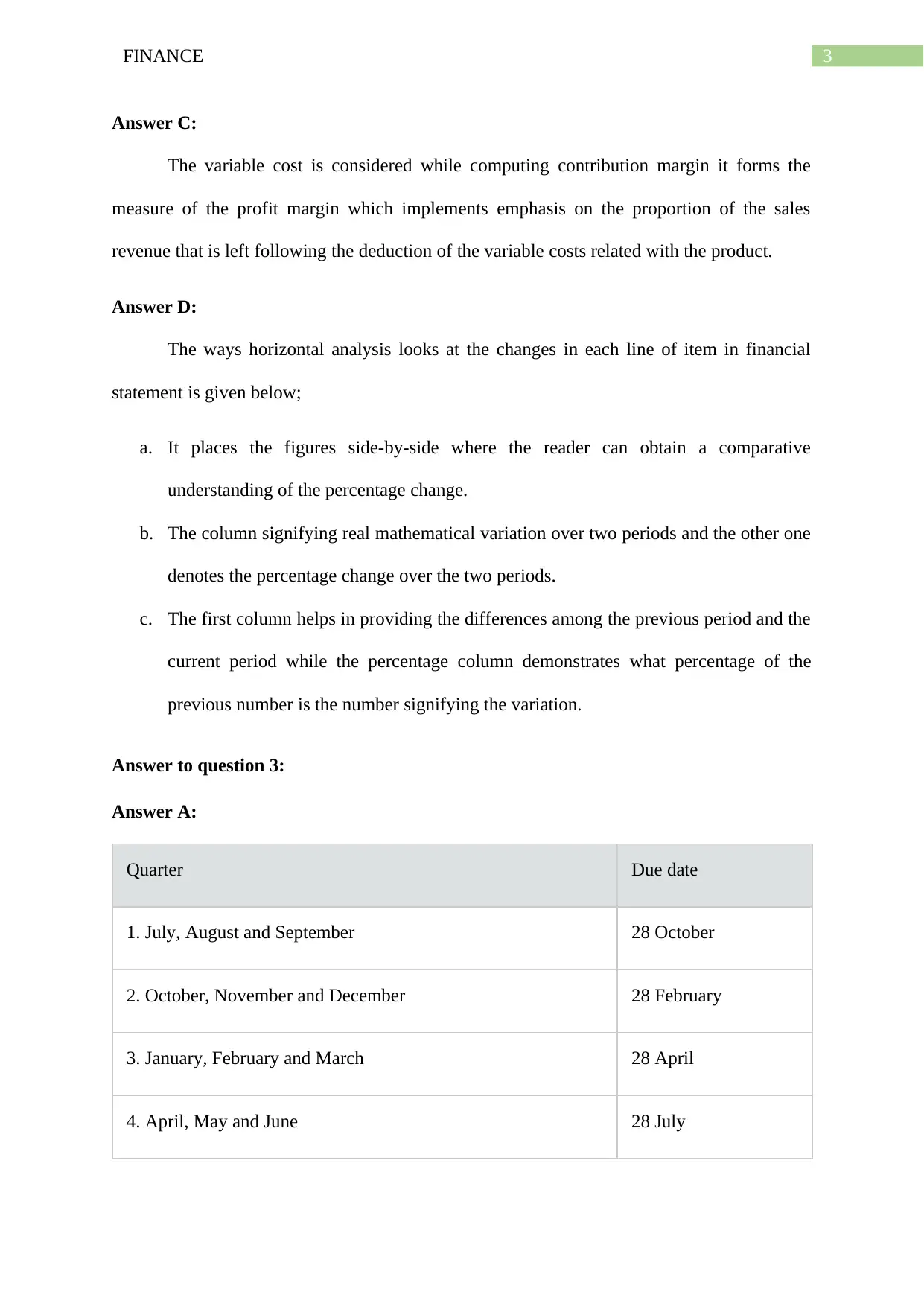
3FINANCE
Answer C:
The variable cost is considered while computing contribution margin it forms the
measure of the profit margin which implements emphasis on the proportion of the sales
revenue that is left following the deduction of the variable costs related with the product.
Answer D:
The ways horizontal analysis looks at the changes in each line of item in financial
statement is given below;
a. It places the figures side-by-side where the reader can obtain a comparative
understanding of the percentage change.
b. The column signifying real mathematical variation over two periods and the other one
denotes the percentage change over the two periods.
c. The first column helps in providing the differences among the previous period and the
current period while the percentage column demonstrates what percentage of the
previous number is the number signifying the variation.
Answer to question 3:
Answer A:
Quarter Due date
1. July, August and September 28 October
2. October, November and December 28 February
3. January, February and March 28 April
4. April, May and June 28 July
Answer C:
The variable cost is considered while computing contribution margin it forms the
measure of the profit margin which implements emphasis on the proportion of the sales
revenue that is left following the deduction of the variable costs related with the product.
Answer D:
The ways horizontal analysis looks at the changes in each line of item in financial
statement is given below;
a. It places the figures side-by-side where the reader can obtain a comparative
understanding of the percentage change.
b. The column signifying real mathematical variation over two periods and the other one
denotes the percentage change over the two periods.
c. The first column helps in providing the differences among the previous period and the
current period while the percentage column demonstrates what percentage of the
previous number is the number signifying the variation.
Answer to question 3:
Answer A:
Quarter Due date
1. July, August and September 28 October
2. October, November and December 28 February
3. January, February and March 28 April
4. April, May and June 28 July
Paraphrase This Document
Need a fresh take? Get an instant paraphrase of this document with our AI Paraphraser
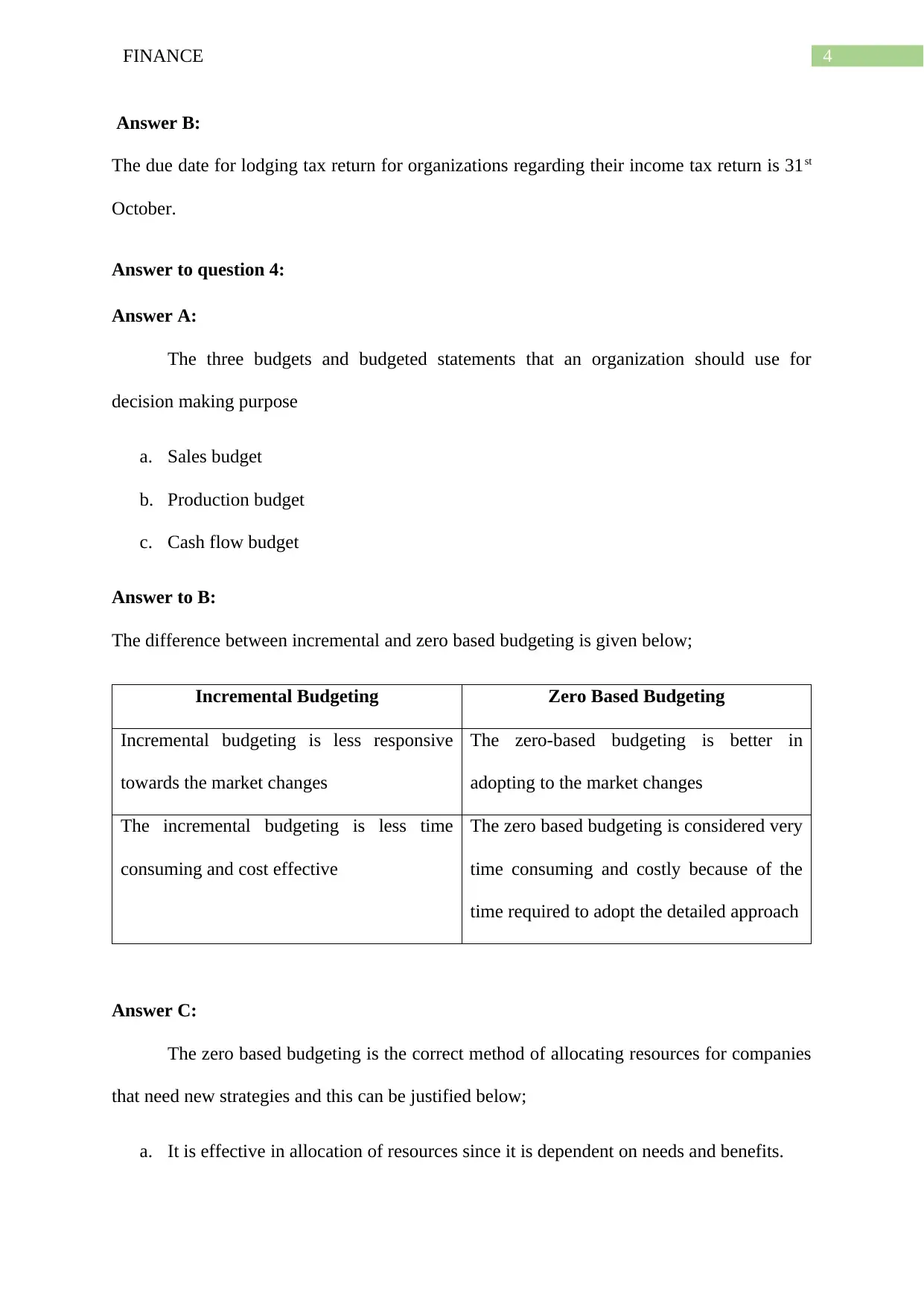
4FINANCE
Answer B:
The due date for lodging tax return for organizations regarding their income tax return is 31st
October.
Answer to question 4:
Answer A:
The three budgets and budgeted statements that an organization should use for
decision making purpose
a. Sales budget
b. Production budget
c. Cash flow budget
Answer to B:
The difference between incremental and zero based budgeting is given below;
Incremental Budgeting Zero Based Budgeting
Incremental budgeting is less responsive
towards the market changes
The zero-based budgeting is better in
adopting to the market changes
The incremental budgeting is less time
consuming and cost effective
The zero based budgeting is considered very
time consuming and costly because of the
time required to adopt the detailed approach
Answer C:
The zero based budgeting is the correct method of allocating resources for companies
that need new strategies and this can be justified below;
a. It is effective in allocation of resources since it is dependent on needs and benefits.
Answer B:
The due date for lodging tax return for organizations regarding their income tax return is 31st
October.
Answer to question 4:
Answer A:
The three budgets and budgeted statements that an organization should use for
decision making purpose
a. Sales budget
b. Production budget
c. Cash flow budget
Answer to B:
The difference between incremental and zero based budgeting is given below;
Incremental Budgeting Zero Based Budgeting
Incremental budgeting is less responsive
towards the market changes
The zero-based budgeting is better in
adopting to the market changes
The incremental budgeting is less time
consuming and cost effective
The zero based budgeting is considered very
time consuming and costly because of the
time required to adopt the detailed approach
Answer C:
The zero based budgeting is the correct method of allocating resources for companies
that need new strategies and this can be justified below;
a. It is effective in allocation of resources since it is dependent on needs and benefits.
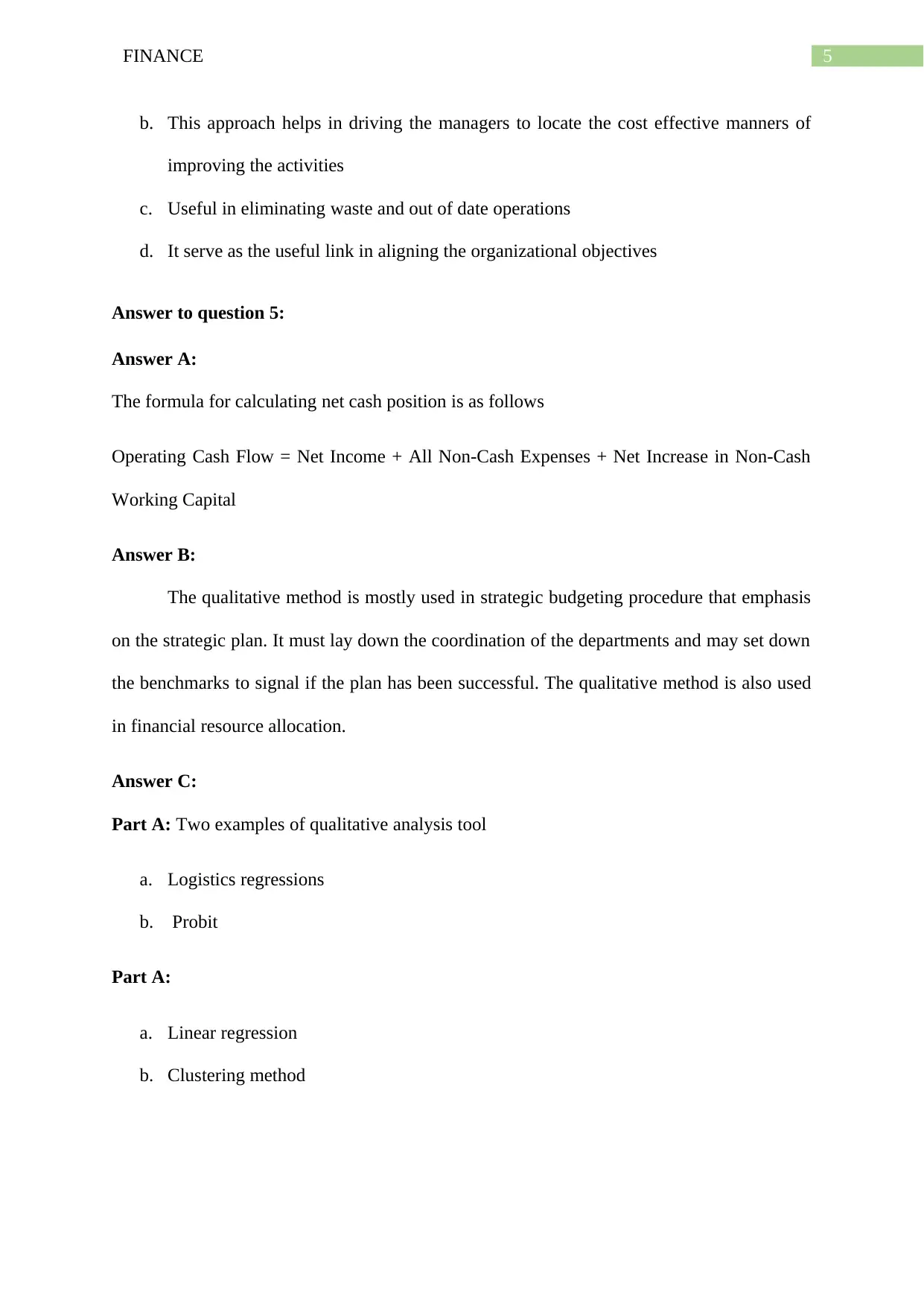
5FINANCE
b. This approach helps in driving the managers to locate the cost effective manners of
improving the activities
c. Useful in eliminating waste and out of date operations
d. It serve as the useful link in aligning the organizational objectives
Answer to question 5:
Answer A:
The formula for calculating net cash position is as follows
Operating Cash Flow = Net Income + All Non-Cash Expenses + Net Increase in Non-Cash
Working Capital
Answer B:
The qualitative method is mostly used in strategic budgeting procedure that emphasis
on the strategic plan. It must lay down the coordination of the departments and may set down
the benchmarks to signal if the plan has been successful. The qualitative method is also used
in financial resource allocation.
Answer C:
Part A: Two examples of qualitative analysis tool
a. Logistics regressions
b. Probit
Part A:
a. Linear regression
b. Clustering method
b. This approach helps in driving the managers to locate the cost effective manners of
improving the activities
c. Useful in eliminating waste and out of date operations
d. It serve as the useful link in aligning the organizational objectives
Answer to question 5:
Answer A:
The formula for calculating net cash position is as follows
Operating Cash Flow = Net Income + All Non-Cash Expenses + Net Increase in Non-Cash
Working Capital
Answer B:
The qualitative method is mostly used in strategic budgeting procedure that emphasis
on the strategic plan. It must lay down the coordination of the departments and may set down
the benchmarks to signal if the plan has been successful. The qualitative method is also used
in financial resource allocation.
Answer C:
Part A: Two examples of qualitative analysis tool
a. Logistics regressions
b. Probit
Part A:
a. Linear regression
b. Clustering method
⊘ This is a preview!⊘
Do you want full access?
Subscribe today to unlock all pages.

Trusted by 1+ million students worldwide
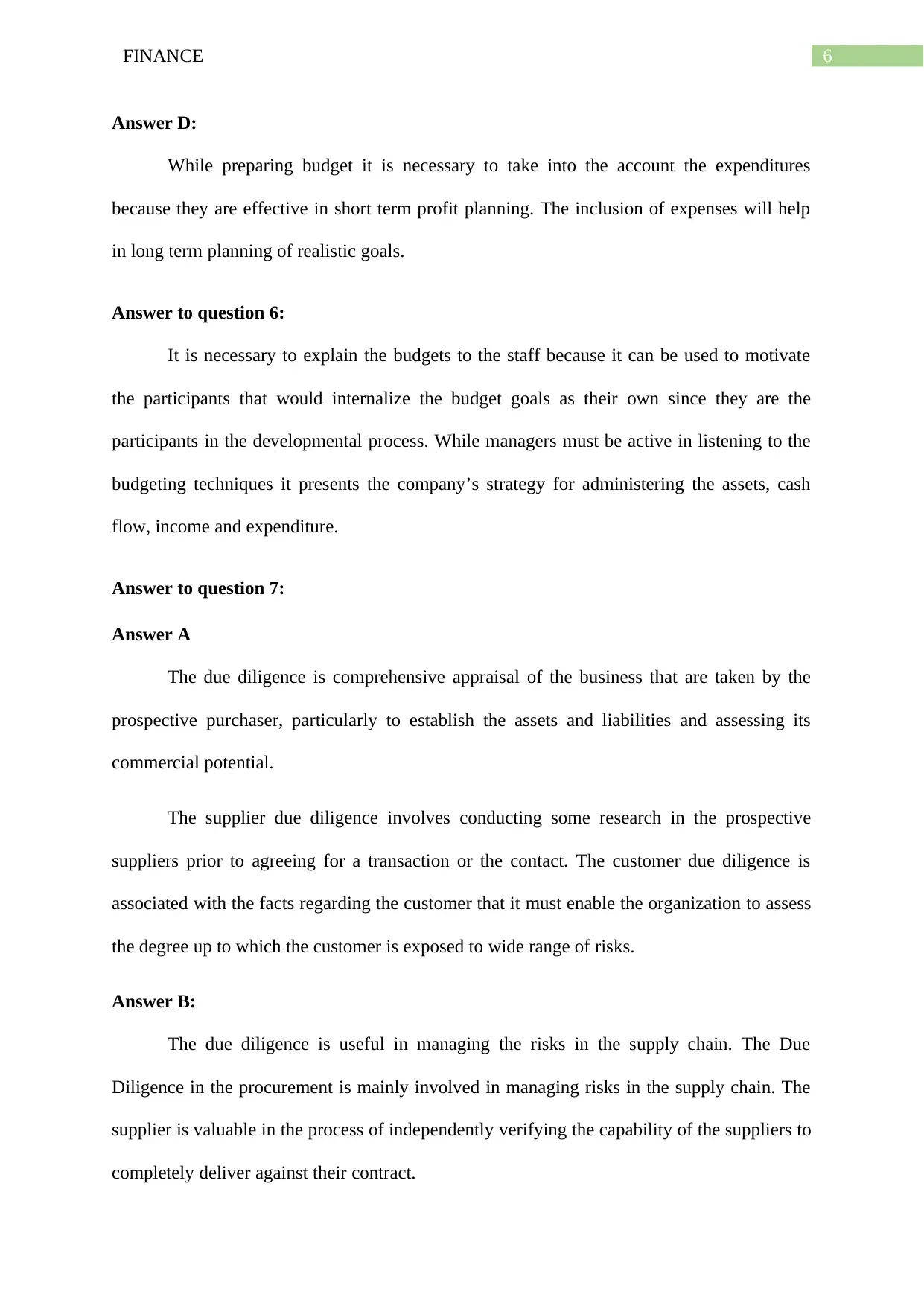
6FINANCE
Answer D:
While preparing budget it is necessary to take into the account the expenditures
because they are effective in short term profit planning. The inclusion of expenses will help
in long term planning of realistic goals.
Answer to question 6:
It is necessary to explain the budgets to the staff because it can be used to motivate
the participants that would internalize the budget goals as their own since they are the
participants in the developmental process. While managers must be active in listening to the
budgeting techniques it presents the company’s strategy for administering the assets, cash
flow, income and expenditure.
Answer to question 7:
Answer A
The due diligence is comprehensive appraisal of the business that are taken by the
prospective purchaser, particularly to establish the assets and liabilities and assessing its
commercial potential.
The supplier due diligence involves conducting some research in the prospective
suppliers prior to agreeing for a transaction or the contact. The customer due diligence is
associated with the facts regarding the customer that it must enable the organization to assess
the degree up to which the customer is exposed to wide range of risks.
Answer B:
The due diligence is useful in managing the risks in the supply chain. The Due
Diligence in the procurement is mainly involved in managing risks in the supply chain. The
supplier is valuable in the process of independently verifying the capability of the suppliers to
completely deliver against their contract.
Answer D:
While preparing budget it is necessary to take into the account the expenditures
because they are effective in short term profit planning. The inclusion of expenses will help
in long term planning of realistic goals.
Answer to question 6:
It is necessary to explain the budgets to the staff because it can be used to motivate
the participants that would internalize the budget goals as their own since they are the
participants in the developmental process. While managers must be active in listening to the
budgeting techniques it presents the company’s strategy for administering the assets, cash
flow, income and expenditure.
Answer to question 7:
Answer A
The due diligence is comprehensive appraisal of the business that are taken by the
prospective purchaser, particularly to establish the assets and liabilities and assessing its
commercial potential.
The supplier due diligence involves conducting some research in the prospective
suppliers prior to agreeing for a transaction or the contact. The customer due diligence is
associated with the facts regarding the customer that it must enable the organization to assess
the degree up to which the customer is exposed to wide range of risks.
Answer B:
The due diligence is useful in managing the risks in the supply chain. The Due
Diligence in the procurement is mainly involved in managing risks in the supply chain. The
supplier is valuable in the process of independently verifying the capability of the suppliers to
completely deliver against their contract.
Paraphrase This Document
Need a fresh take? Get an instant paraphrase of this document with our AI Paraphraser
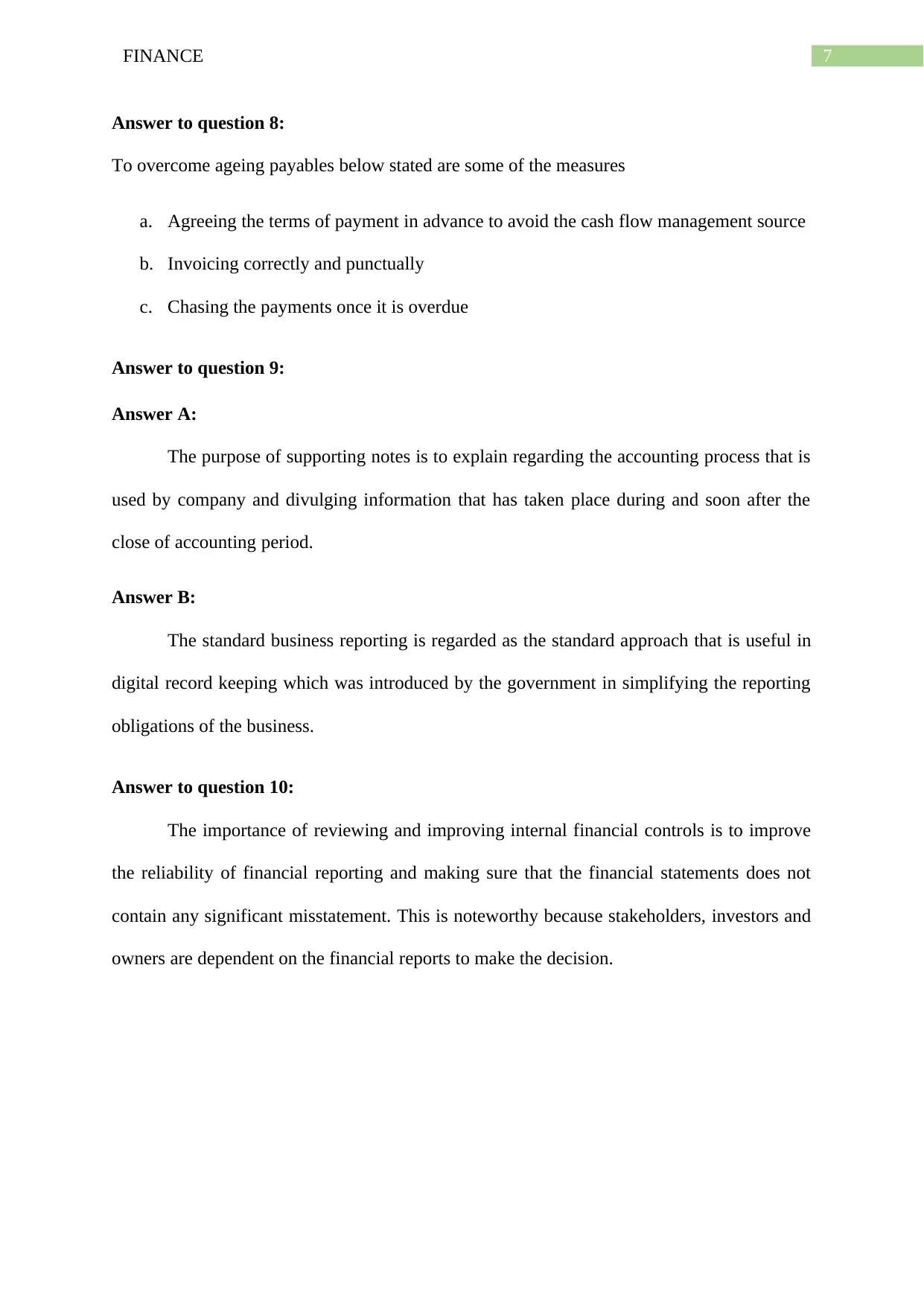
7FINANCE
Answer to question 8:
To overcome ageing payables below stated are some of the measures
a. Agreeing the terms of payment in advance to avoid the cash flow management source
b. Invoicing correctly and punctually
c. Chasing the payments once it is overdue
Answer to question 9:
Answer A:
The purpose of supporting notes is to explain regarding the accounting process that is
used by company and divulging information that has taken place during and soon after the
close of accounting period.
Answer B:
The standard business reporting is regarded as the standard approach that is useful in
digital record keeping which was introduced by the government in simplifying the reporting
obligations of the business.
Answer to question 10:
The importance of reviewing and improving internal financial controls is to improve
the reliability of financial reporting and making sure that the financial statements does not
contain any significant misstatement. This is noteworthy because stakeholders, investors and
owners are dependent on the financial reports to make the decision.
Answer to question 8:
To overcome ageing payables below stated are some of the measures
a. Agreeing the terms of payment in advance to avoid the cash flow management source
b. Invoicing correctly and punctually
c. Chasing the payments once it is overdue
Answer to question 9:
Answer A:
The purpose of supporting notes is to explain regarding the accounting process that is
used by company and divulging information that has taken place during and soon after the
close of accounting period.
Answer B:
The standard business reporting is regarded as the standard approach that is useful in
digital record keeping which was introduced by the government in simplifying the reporting
obligations of the business.
Answer to question 10:
The importance of reviewing and improving internal financial controls is to improve
the reliability of financial reporting and making sure that the financial statements does not
contain any significant misstatement. This is noteworthy because stakeholders, investors and
owners are dependent on the financial reports to make the decision.
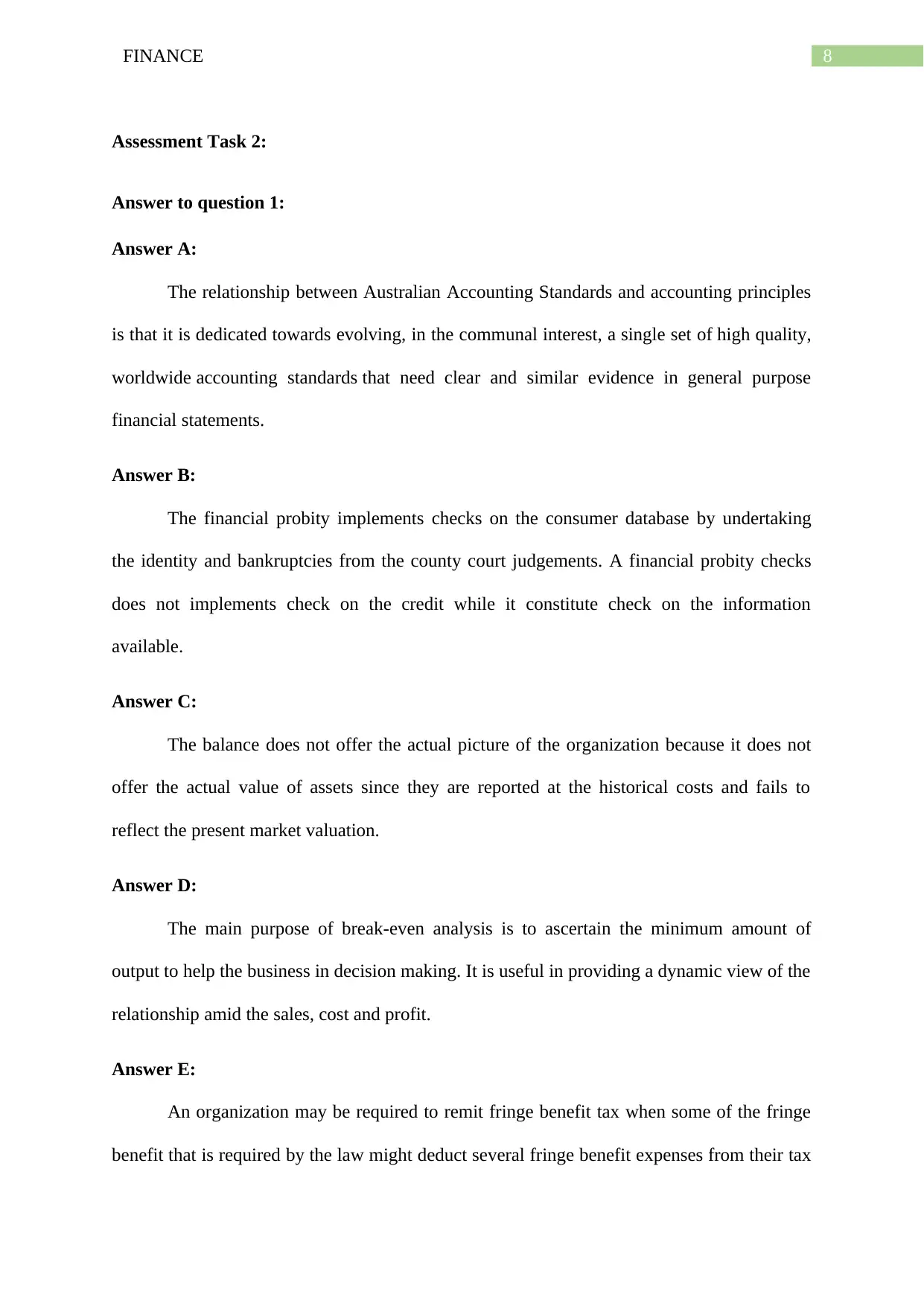
8FINANCE
Assessment Task 2:
Answer to question 1:
Answer A:
The relationship between Australian Accounting Standards and accounting principles
is that it is dedicated towards evolving, in the communal interest, a single set of high quality,
worldwide accounting standards that need clear and similar evidence in general purpose
financial statements.
Answer B:
The financial probity implements checks on the consumer database by undertaking
the identity and bankruptcies from the county court judgements. A financial probity checks
does not implements check on the credit while it constitute check on the information
available.
Answer C:
The balance does not offer the actual picture of the organization because it does not
offer the actual value of assets since they are reported at the historical costs and fails to
reflect the present market valuation.
Answer D:
The main purpose of break-even analysis is to ascertain the minimum amount of
output to help the business in decision making. It is useful in providing a dynamic view of the
relationship amid the sales, cost and profit.
Answer E:
An organization may be required to remit fringe benefit tax when some of the fringe
benefit that is required by the law might deduct several fringe benefit expenses from their tax
Assessment Task 2:
Answer to question 1:
Answer A:
The relationship between Australian Accounting Standards and accounting principles
is that it is dedicated towards evolving, in the communal interest, a single set of high quality,
worldwide accounting standards that need clear and similar evidence in general purpose
financial statements.
Answer B:
The financial probity implements checks on the consumer database by undertaking
the identity and bankruptcies from the county court judgements. A financial probity checks
does not implements check on the credit while it constitute check on the information
available.
Answer C:
The balance does not offer the actual picture of the organization because it does not
offer the actual value of assets since they are reported at the historical costs and fails to
reflect the present market valuation.
Answer D:
The main purpose of break-even analysis is to ascertain the minimum amount of
output to help the business in decision making. It is useful in providing a dynamic view of the
relationship amid the sales, cost and profit.
Answer E:
An organization may be required to remit fringe benefit tax when some of the fringe
benefit that is required by the law might deduct several fringe benefit expenses from their tax
⊘ This is a preview!⊘
Do you want full access?
Subscribe today to unlock all pages.

Trusted by 1+ million students worldwide
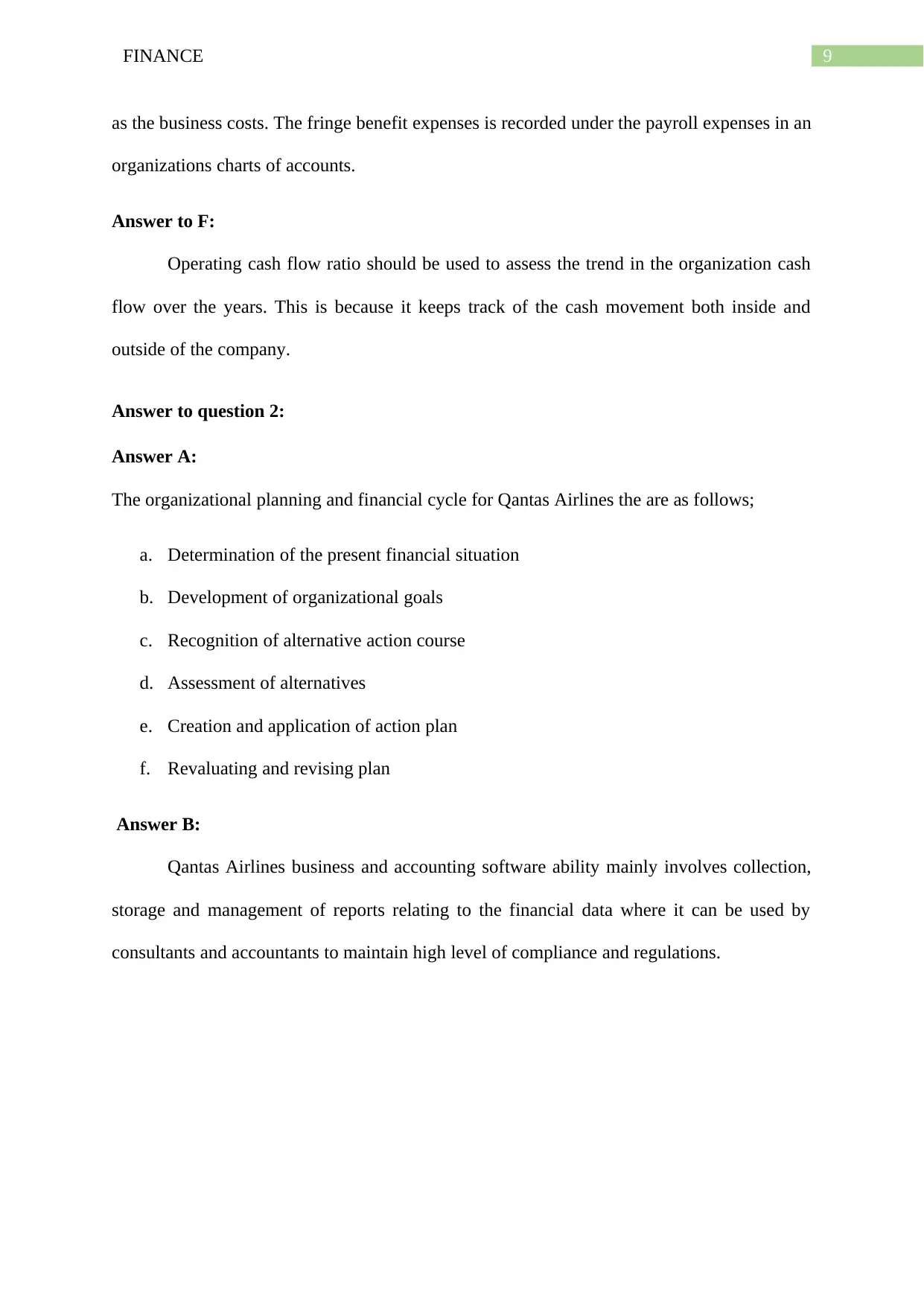
9FINANCE
as the business costs. The fringe benefit expenses is recorded under the payroll expenses in an
organizations charts of accounts.
Answer to F:
Operating cash flow ratio should be used to assess the trend in the organization cash
flow over the years. This is because it keeps track of the cash movement both inside and
outside of the company.
Answer to question 2:
Answer A:
The organizational planning and financial cycle for Qantas Airlines the are as follows;
a. Determination of the present financial situation
b. Development of organizational goals
c. Recognition of alternative action course
d. Assessment of alternatives
e. Creation and application of action plan
f. Revaluating and revising plan
Answer B:
Qantas Airlines business and accounting software ability mainly involves collection,
storage and management of reports relating to the financial data where it can be used by
consultants and accountants to maintain high level of compliance and regulations.
as the business costs. The fringe benefit expenses is recorded under the payroll expenses in an
organizations charts of accounts.
Answer to F:
Operating cash flow ratio should be used to assess the trend in the organization cash
flow over the years. This is because it keeps track of the cash movement both inside and
outside of the company.
Answer to question 2:
Answer A:
The organizational planning and financial cycle for Qantas Airlines the are as follows;
a. Determination of the present financial situation
b. Development of organizational goals
c. Recognition of alternative action course
d. Assessment of alternatives
e. Creation and application of action plan
f. Revaluating and revising plan
Answer B:
Qantas Airlines business and accounting software ability mainly involves collection,
storage and management of reports relating to the financial data where it can be used by
consultants and accountants to maintain high level of compliance and regulations.
Paraphrase This Document
Need a fresh take? Get an instant paraphrase of this document with our AI Paraphraser
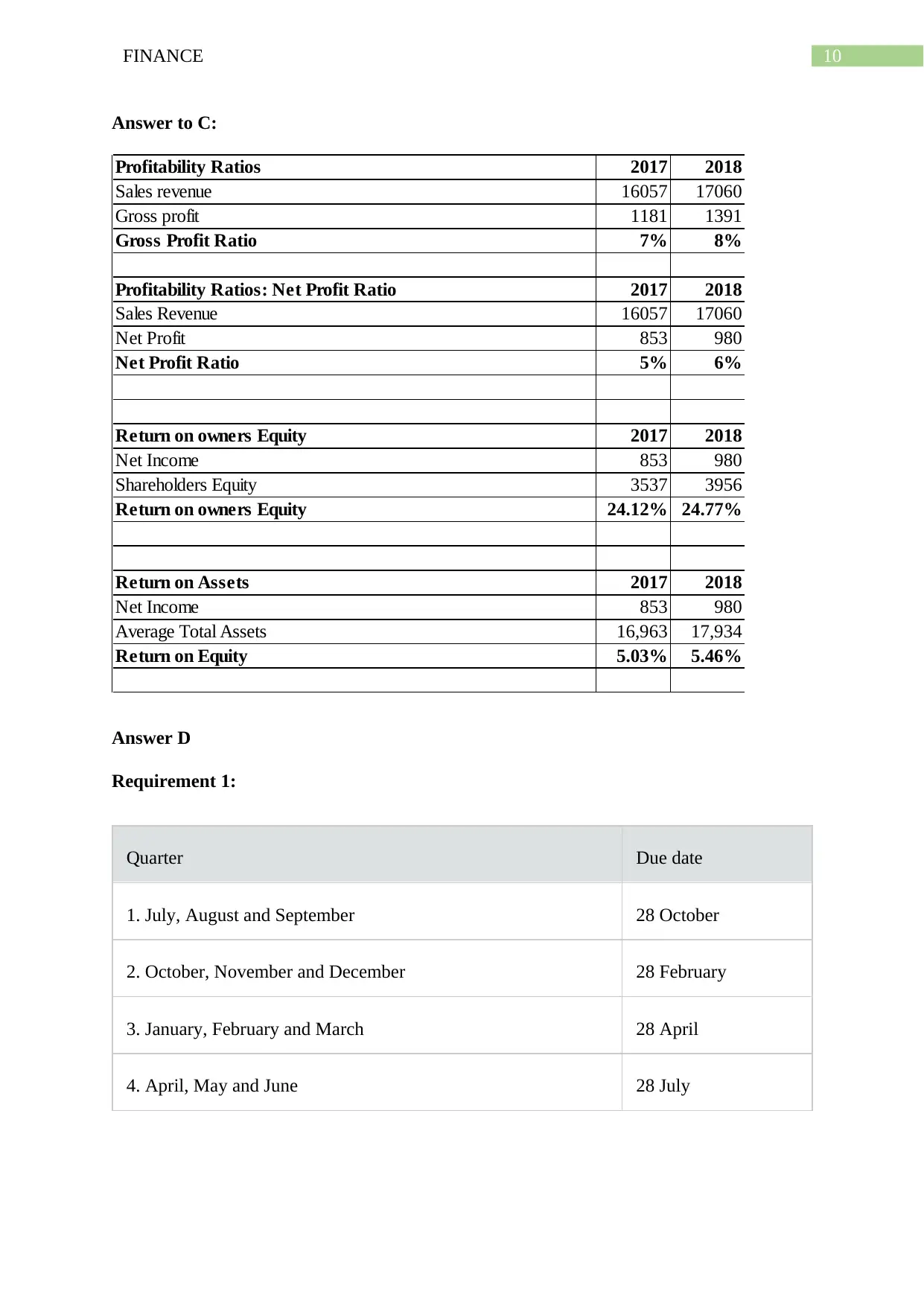
10FINANCE
Answer to C:
Profitability Ratios 2017 2018
Sales revenue 16057 17060
Gross profit 1181 1391
Gross Profit Ratio 7% 8%
Profitability Ratios: Net Profit Ratio 2017 2018
Sales Revenue 16057 17060
Net Profit 853 980
Net Profit Ratio 5% 6%
Return on owners Equity 2017 2018
Net Income 853 980
Shareholders Equity 3537 3956
Return on owners Equity 24.12% 24.77%
Return on Assets 2017 2018
Net Income 853 980
Average Total Assets 16,963 17,934
Return on Equity 5.03% 5.46%
Answer D
Requirement 1:
Quarter Due date
1. July, August and September 28 October
2. October, November and December 28 February
3. January, February and March 28 April
4. April, May and June 28 July
Answer to C:
Profitability Ratios 2017 2018
Sales revenue 16057 17060
Gross profit 1181 1391
Gross Profit Ratio 7% 8%
Profitability Ratios: Net Profit Ratio 2017 2018
Sales Revenue 16057 17060
Net Profit 853 980
Net Profit Ratio 5% 6%
Return on owners Equity 2017 2018
Net Income 853 980
Shareholders Equity 3537 3956
Return on owners Equity 24.12% 24.77%
Return on Assets 2017 2018
Net Income 853 980
Average Total Assets 16,963 17,934
Return on Equity 5.03% 5.46%
Answer D
Requirement 1:
Quarter Due date
1. July, August and September 28 October
2. October, November and December 28 February
3. January, February and March 28 April
4. April, May and June 28 July
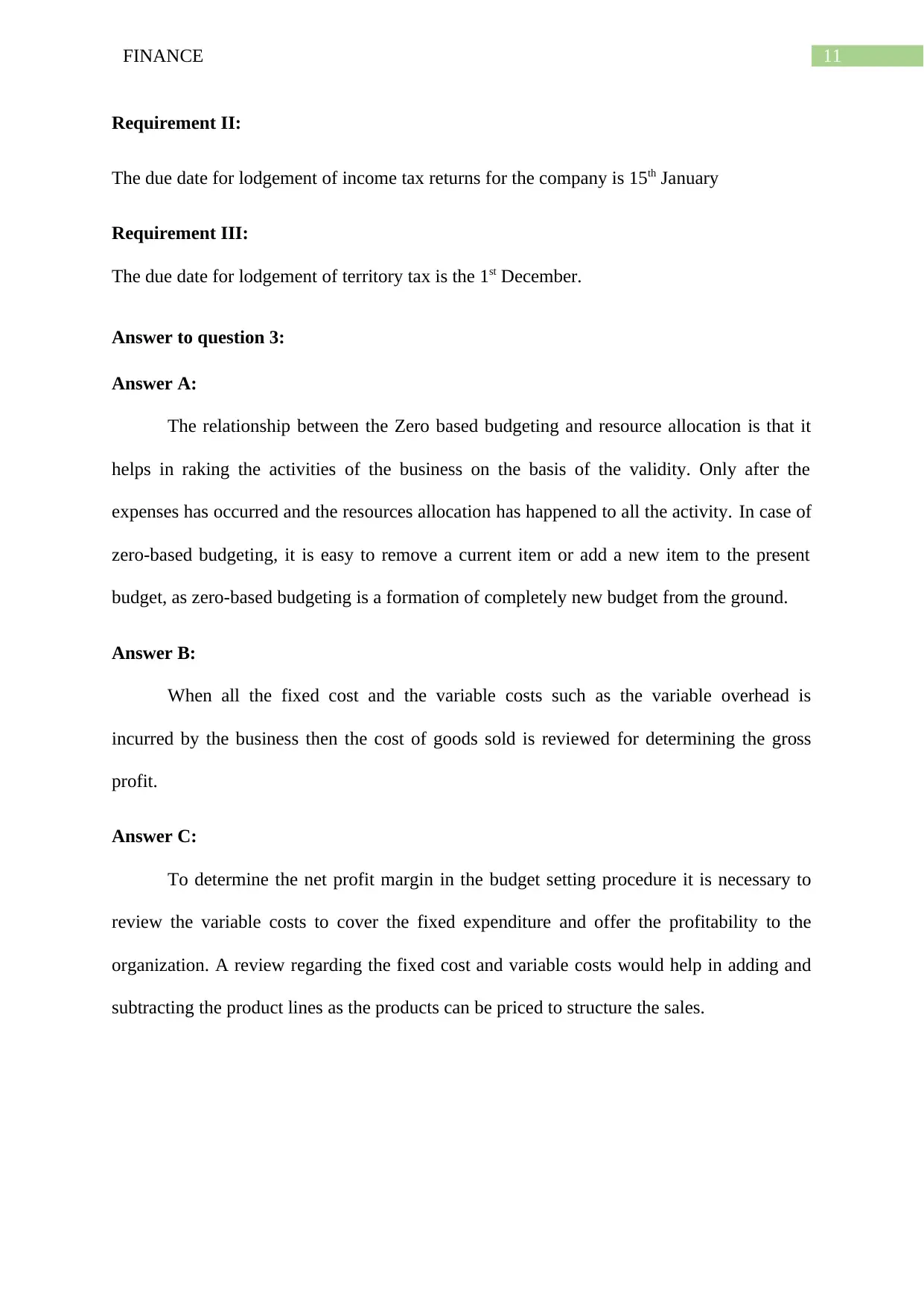
11FINANCE
Requirement II:
The due date for lodgement of income tax returns for the company is 15th January
Requirement III:
The due date for lodgement of territory tax is the 1st December.
Answer to question 3:
Answer A:
The relationship between the Zero based budgeting and resource allocation is that it
helps in raking the activities of the business on the basis of the validity. Only after the
expenses has occurred and the resources allocation has happened to all the activity. In case of
zero-based budgeting, it is easy to remove a current item or add a new item to the present
budget, as zero-based budgeting is a formation of completely new budget from the ground.
Answer B:
When all the fixed cost and the variable costs such as the variable overhead is
incurred by the business then the cost of goods sold is reviewed for determining the gross
profit.
Answer C:
To determine the net profit margin in the budget setting procedure it is necessary to
review the variable costs to cover the fixed expenditure and offer the profitability to the
organization. A review regarding the fixed cost and variable costs would help in adding and
subtracting the product lines as the products can be priced to structure the sales.
Requirement II:
The due date for lodgement of income tax returns for the company is 15th January
Requirement III:
The due date for lodgement of territory tax is the 1st December.
Answer to question 3:
Answer A:
The relationship between the Zero based budgeting and resource allocation is that it
helps in raking the activities of the business on the basis of the validity. Only after the
expenses has occurred and the resources allocation has happened to all the activity. In case of
zero-based budgeting, it is easy to remove a current item or add a new item to the present
budget, as zero-based budgeting is a formation of completely new budget from the ground.
Answer B:
When all the fixed cost and the variable costs such as the variable overhead is
incurred by the business then the cost of goods sold is reviewed for determining the gross
profit.
Answer C:
To determine the net profit margin in the budget setting procedure it is necessary to
review the variable costs to cover the fixed expenditure and offer the profitability to the
organization. A review regarding the fixed cost and variable costs would help in adding and
subtracting the product lines as the products can be priced to structure the sales.
⊘ This is a preview!⊘
Do you want full access?
Subscribe today to unlock all pages.

Trusted by 1+ million students worldwide
1 out of 17
Related Documents
Your All-in-One AI-Powered Toolkit for Academic Success.
+13062052269
info@desklib.com
Available 24*7 on WhatsApp / Email
![[object Object]](/_next/static/media/star-bottom.7253800d.svg)
Unlock your academic potential
Copyright © 2020–2025 A2Z Services. All Rights Reserved. Developed and managed by ZUCOL.





